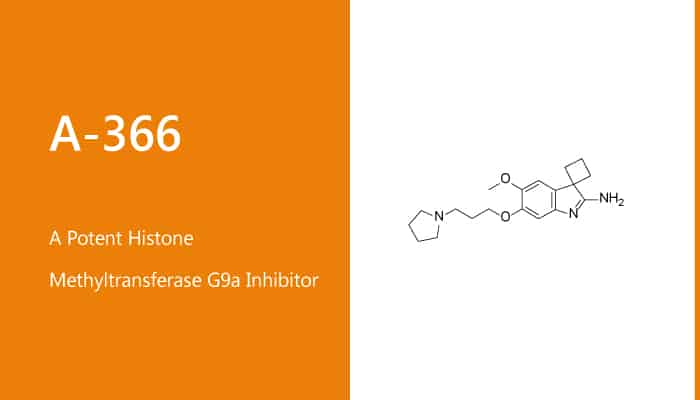Epigenetic alterations to the genome take place via modifications to the DNA or histones. Meanwhile, those modifications lead to changes in gene expression. Generally, histone lysine methylation is a prominent kind of epigenetic regulation for change of the structure chromatin and gene expression. HMTs have recently generated increasing interest in its therapeutic value in human disease.
G9a and G9a-like protein are HMTs. They can catalyze the mono- and di-methylation of lysine 9 on histone 3 (H3K9me1/2). In a body of literature, the potential link of G9a to a variety of cancers
G9a has a potential link to many cancers, such as leukemias, prostate cancer, hepatocellular carcinoma, and lung cancer.
In this article, we will introduce a potent histone methyltransferase G9a inhibitor A-366 with an IC50 of 3.3 nM in vitro and in vivo.

Firstly, in myelocytic leukemia (AML) cell line MV4;11, A-366 can result in differentiation of this tumor cell line as a dose-dependent manner.
In long-term treatment, A-366 also inhibits proliferation and viability by CD11b staining observation. Whatmore, this compound results in a dose-dependent transition towards sub G1/G0 content consistent with the CD11b staining result.
In the short term observation, A-366 can produce similar but less dramatic effects. A-366 also affects cell morphologication, it increases cytoplasm: nucleus ratio and nuclear lobulation ( indicative of differentiation).
In vivo, in SCID/bg mice with MV4;11 cells, the volume of the tumor reaches ~200 mm3. A-366 treatment to mice at 30 mg/kg/day by osmotic mini-pump for 14 days exhibits no toxicity. In this experiment, A-366 results in a modest 45% tumor growth inhibition. Finally, A-366 exerts a slow but steady decrease in total H3K9me2 levels.
In summary, A-366 can selectively inhibit G9a without affect other histone methyltransferases.
A-366 exhibits lightened cytotoxic effects on cancer cells. Besides, A-366 plays an important role in remaining the G9a/GLP in leukemia. Furthermore, in the mouse model, A-366 significantly results in tumor growth inhibition.
Reference:
Pappano WN, et al. PLoS One. 2015 Jul 6;10(7):e0131716.